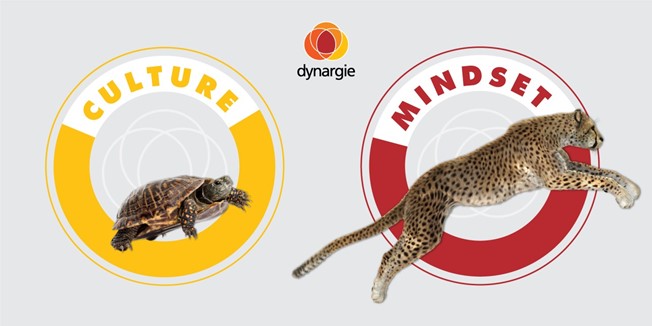Menos Cultura, Mais Mindset
Todos nós tendemos a concordar que não existe empresa sem cultura. Baseada em seus costumes, rotinas e comportamentos, uma cultura confere às empresas uma identidade própria, independentemente de gostarmos ou não delas. Ironicamente, só poderíamos imaginar uma empresa sem cultura se não tivesse todas essas formas humanas de se comportar e criar memórias coletivas.
A questão que se coloca hoje é se a velocidade com que as organizações mudam pode suportar a lentidão da mudança de seus padrões culturais. Em outras palavras, a cultura de uma empresa deve ser vista como um ativo. Então, quando as coisas começam a complicar e deixam de envolver os funcionários em uma finalidade específica, isto torna-se um passivo.
Consequentemente, e se aceitarmos a premissa de que não existem empresas sem uma cultura intrínseca, temos um problema: da estabilidade de um casamento entre empresa e cultura, passamos para a inevitabilidade do divórcio. Existem, no entanto, soluções para tornar o divórcio amigável. Se a cultura é muito pesada e muito profundamente enraizada para suportar o ritmo da mudança imposta pelas empresas, em particular, e a sociedade em geral, a alternativa é destacar outro ativo. Isto é, inevitavelmente, mais leve, mais adaptável, quase poderia se dizer, mais compreensivo com as mudanças em seu parceiro: a empresa.
Mas sempre nos atendo ao objetivo: manter hoje todos focados; garantindo a cooperação entre todos, também uma memória coletiva, pois é isso que pode garantir um futuro de pertencimento e confiança no projeto. E esse ativo, que também tem direitos e deveres para com a empresa, é o Mindset. Mais rápido de definir, mais fácil de decidir, mais fácil de comunicar, mais fácil de medir e, acima de tudo, mais fácil de mudar.
Exemplos? Vamos imaginar uma empresa familiar que foi vendida a um comprador de Private Equity. Enquanto esperamos que a cultura se adapte às novas formas de gestão, o comprador de Private Equity já vendeu a empresa … E mesmo com tudo o que aconteceu no ano passado, se tivéssemos mais mindset do que cultura, muitas mudanças teriam sido mais rápidas e menos dolorosas.
A Dynargie começou a brincar com o mindset há cerca de 10 anos. Devido à nossa experiência acumulada em diferentes projetos em diferentes países, não é mais uma brincadeira. Hoje, conseguimos parametrizar o mindset de uma equipe, departamento ou empresa em três dimensões – BE (Orientado para Propósito), SAY (Orientado para Pessoas) e DO (Orientado para Resultados) – tendo cada dimensão quatro clusters, permitindo assim uma análise muito mais refinada e precisa.
E o mindset da sua empresa? É o adequado para a sua estratégia? Talvez valesse a pena medi-lo!
João Barbosa
CEO Dynargie Internacional
Less Culture, More Mindset
We’ll all tend to agree that there’s no such thing as a company without a culture. Based on their customs, routines and behaviour, a culture gives companies their own identity, regardless of whether we like them or not. Ironically, we could only imagine a company without a culture if it didn’t have all these human ways of behaving and creating collective memories.
The question that arises today is whether the speed with which organizations change can withstand the slowness of changing their cultural patterns. In other words, the culture of a company should be seen as an asset; so, when it starts to complicate things and fails to involve employees in a particular purpose, it becomes a liability.
Consequently, and if we accept the premise that there are no companies without an intrinsic culture, we have a problem: from the stability of a marriage between company and culture, we switch to the inevitability of a divorce. There are, however, solutions to make the divorce amicable. If the culture is too weighty and too deeply rooted to withstand the pace of change imposed by companies, in particular, and society in general; the alternative is to highlight another asset. This is inevitably lighter, more adaptive, you could almost say, more empathetic with the changes in its partner: the company. But always sticking to the purpose: gluing today; guaranteeing cooperation between everyone and ensuring a collective memory, as this is what ensures a future of belonging and trust in the project. And this asset, which also has its rights and duties to the company, is the Mindset. Faster to define, easier to decide, easier to communicate, easier to measure and, above all, easier to change.
Examples? Let’s imagine a family business that has been sold to a Private Equity buyer. While we’re waiting for the culture to adapt to the new forms of management, the Private Equity buyer has already sold the company… And even with everything that has happened over the last year, if we’d had more mindset than culture, many changes would have been faster and less painful.
Dynargie started playing with mindsets about 10 years ago. Due to our accumulated experience in different projects in different countries, it’s no longer a joke. Today, we’ve managed to parameterize the mindset of a team, a department, or a company in three dimensions – BE (Purpose oriented), SAY (People oriented) and DO (Performance oriented) – with each dimension having four clusters, thus allowing a much finer and more precise analysis.
And your company’s mindset? Is it right for your strategy? Maybe it’d be worth measuring it!
João Barbosa
CEO Dynargie Internacional








Comentário